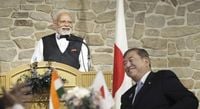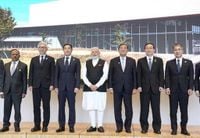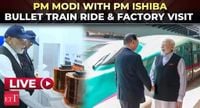On August 30, 2025, the partnership between India and Japan entered a new era as Prime Minister Narendra Modi wrapped up a landmark two-day visit to Japan, culminating in a comprehensive roadmap to deepen strategic, economic, and technological ties over the coming decade. The visit, marked by symbolism, substance, and a flurry of agreements, underscored the two nations’ shared aspiration for a free, open, and prosperous Indo-Pacific, anchored in the rule of law and mutual trust.
Modi’s trip began in Tokyo, where he was greeted with the illumination of the iconic SkyTree in the colors of the Indian tricolor—a gesture that set the tone for a visit steeped in warmth and ambition. The centerpiece of the summit was the unveiling of a joint vision statement with Japanese Prime Minister Shigeru Ishiba, outlining eight lines of effort to guide the bilateral relationship through the next decade. According to KNN India, these pillars span economic relations, economic security, mobility, technology and innovation, ecological sustainability, health, people-to-people exchanges, and partnerships between Indian states and Japanese prefectures.
One of the most eye-catching announcements was a new target: JPY 10 trillion in Japanese private investment into India. This significant commitment builds on Japan’s already robust investment history, with Prime Minister Modi noting that Japanese companies have invested more than $40 billion in India, including $13 billion in just the last two years. "Investments in India don’t just grow, they multiply," Modi said at the India-Japan Economic Forum in Tokyo, highlighting the country’s strong economic fundamentals, political stability, and transparent policies. He pointed to a recent JETRO survey, which found that 80% of Japanese companies want to expand in India and 75% are already making profits.
The summit’s agenda was ambitious, covering trade, industrial cooperation, financial linkages, food security, agriculture, and SME partnerships. A new Economic Security Initiative was launched, focusing on supply chain resilience, market diversification, and joint projects in semiconductors, critical minerals, clean energy, and advanced technologies. Notably, the two countries announced an India-Japan AI Cooperation Initiative (JAI) and enhanced collaboration in battery supply chains, as reported by KNN India.
Mobility and infrastructure were also in the spotlight. The leaders launched a Next Generation Mobility Partnership to co-develop high-speed rail, advanced metro systems, smart cities, and cold-chain logistics. During the visit, Modi and Ishiba traveled together on the Shinkansen bullet train from Tokyo to Sendai—a symbolic gesture that could foreshadow the introduction of Japan’s E10 Shinkansen bullet trains in India. The trip also included a visit to a bullet-train coach manufacturing site and a meeting with Indian train drivers undergoing training at the East Japan Railway Company.
Perhaps the most strategic stop was the tour of the Tokyo Electron semiconductor factory in Miyagi prefecture. There, Modi and Ishiba were briefed on the plant’s role in the global semiconductor value chain and ongoing collaborations with India. The facility, developed by Taiwan’s Powerchip Semiconductor Manufacturing Corporation in partnership with SBI Holdings and Japanese firms under the Japan Semiconductor Manufacturing Company, highlights the complementarity between India’s growing semiconductor ecosystem and Japan’s technological strengths. Ishiba remarked, "We hope to work together to strengthen the semiconductor supply chain and enhance economic security," according to coverage by international outlets.
Science, research, and innovation featured prominently in the summit’s outcomes. The two sides committed to joint work in quantum technologies, space exploration—including the LUPEX lunar mission and a new collaboration between ISRO and JAXA on Chandrayaan-5—nuclear research, food sciences, and the development of startup ecosystems. Joint funding mechanisms will support emerging technology ventures, aiming to make the partnership a driver of the technological revolution of this century. Modi, speaking at the summit, emphasized, "Japanese technology and Indian talent are a winning combination."
Health and sustainability were not left behind. India and Japan agreed to strengthen efforts on universal health coverage, medical research, geriatric care, regenerative medicine, and pandemic preparedness. The partnership will also expand cooperation in traditional and holistic medicine, with new centers of excellence for Ayurveda and yoga in Japan. On the ecological front, both countries pledged closer work on climate action, clean energy, circular economy practices, and biodiversity conservation. Initiatives will include green hydrogen value chains, waste-to-energy projects, and expanded collaboration under the India-Japan Clean Energy Partnership.
People-to-people ties received a major boost with the announcement of an Action Plan for Human Resource Exchange, targeting over 500,000 personnel exchanges in five years—including 50,000 skilled workers from India to Japan. Education, language training, student mobility, and cultural tourism will all be expanded. Modi personally met with the governors of 16 Japanese prefectures, urging action under the State-Prefecture Partnership Initiative to foster deeper ties in technology, investment, innovation, and start-ups.
The summit was not only about economics and technology. Cultural diplomacy was on display as Modi gifted a Pashmina shawl from Kashmir to Japanese First Lady Yoshiko Ishiba, symbolizing the centuries-old artistry and heritage of India. He also received a Daruma doll from the chief priest of Tokyo’s Shorinzan Daruma-Ji Temple—a gift with deep cultural ties to both nations. On social media, Modi expressed gratitude, writing, "The Daruma is an important cultural symbol in Japan, with its origins derived from the influence of the high monk Bodhidharma, and it has deep ties to India as well."
Thirteen key agreements and declarations were signed during the visit, covering sectors such as clean energy, critical minerals, digital technologies, space, cultural exchanges, environment, and diplomatic training. As Foreign Secretary Vikram Misri explained, "This is a 10-year strategic roadmap in economic and functional cooperation between the two sides... Japan today is one of India’s most valued and trusted friends. It is a partner for us in our journey toward a developed and self-reliant India." He added that the relationship remains a pillar of stability in the international system, especially amid considerable geopolitical flux.
Defence and regional security were also on the agenda, with both leaders discussing the Quad grouping (India, Japan, the US, and Australia) and exploring ways to strengthen peace and stability in the Indo-Pacific. Modi reaffirmed India’s commitment to its partnerships with the United States, China, and Russia, viewing the summit as a springboard for advancing national interests and regional cooperation.
As the visit concluded, Modi departed for China to attend the Shanghai Cooperation Organisation summit, confident that the outcomes in Japan would advance India’s priorities and strengthen its role as a bridge to the Global South. "This visit to Japan will be remembered for the productive outcomes which will benefit the people of our nations. I thank PM Ishiba, the Japanese people and the Government for their warmth," Modi wrote on X.
The joint vision adopted in Tokyo stands as a transformative framework, aiming not only to consolidate India and Japan’s Special Strategic and Global Partnership but also to set a benchmark for international cooperation in a rapidly changing world.



